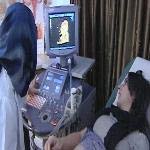
Newly released data by the US Centers for Disease Control and Prevention (CDC) show an alarming increase in caesarean deliveries in the United States. And a recent global survey by the World Health Organization found that more than one in four women in Asia delivered by cesarean section. Human rights organizations say C-sections are being performed too often, exposing women and babies to the risks of major surgery.
Laiqa Ahmed recently moved to the US from Britain. She is pregnant with her second child and is hoping to have a vaginal delivery but she worries about it. Some of her friends have complained that American doctors are too quick to choose surgery.
"I had my daughter in England, and there they disagree with C-sections unless there is no other option left and you are in a life threatening situation," she explained.
Ahmed's fears are not unwarranted. In 2007, one in three babies born in the U.S. were delivered by C-section. That's more than in most industrialized countries.
In the developing world, the number of C-sections has also spiked. The World Health Organization reports that in Asia one in four babies is born by caesarean.
The WHO estimates that only 15 percent of deliveries require a C-section. But some doctors in the US say they have to be extra careful.
"In this litigational society, you don't want to have a bad ending," noted Dr. Mutahar Fauzia who practices obstetrics in Virginia.
She says doctors should stop performing C-sections for non-medical reasons because the risk to the mother, with each each caesarean, increases.
The uterus could rupture and cause fatal hemorrhaging.
Repeated C-sections can also cause abnormalities in the placenta, which feeds the fetus during pregnancy.
Dr. Fauzia says last year 86 percent of her patients delivered vaginally. She says some medical practices increase the likelihood of having to resort to surgery.
"If you rupture the membranes you end up doing C-sections most of the time. So what I did, I started doing less pelvic exams because if the membranes are intact, the head rotates. But it takes a long time. I have at times waited eight hours - you cannot even believe - eight hours after full dilatation and [my patient] ended up having a normal delivery," added Dr. Fauzia.
In the US, there's another reason why so many women have their babies by caesarean section.
Many delay childbearing until their 30s or 40s when it is more difficult to deliver vaginally.
But the biggest increase in demand for C-sections is coming from women in their 20s.
Dr. Fauzia says she tries to stay calm when her patients are in pain and are urging her to do a C-section.
Vishnu Priya delivered her first child vaginally. She says it was possible only because her doctor did not get impatient.
"She waited so long, and she kept saying push the baby, push the baby, and finally I had my baby and it was normal [delivery]," she said.
Amnestly International has called the increase in caesarean sections a maternal health care crisis. The organization says President Obama should act now.
"We are urging President Obama and Kathleen Sebelius, head of (the) Health and Human Services Department to open an office of maternal health that would produce evidence-based guidelines so that we don't have C-section rates which are more than twice of what the World Health Organization recommends or mandates," said Sameer Dossani of Amnesty International.
A panel convened by the U.S. National Institutes of Health said the number of initial C-sections should be reduced, but it did not issue specific guidelines.
caesarean delivery: 剖腹生產(chǎn)
C-section: 剖腹產(chǎn)
vaginal delivery: 陰道分娩
litigational: of or related to the process of making or defending a claim in a court of law 訴訟的
obstetrics: the branch of medicine concerned with the birth of children 產(chǎn)科學(xué)
uterus: the organ in women and female animals in which babies develop before they are born 子宮
hemorrhage: 體內(nèi)(大)出血
placenta: the material that comes out of a woman or female animal's body after a baby has been born, and which was necessary to feed and protect the baby 胎盤
pelvic: 骨盆的
dilatation: 擴(kuò)張術(shù)
(來源:VOA 編輯:陳丹妮)
